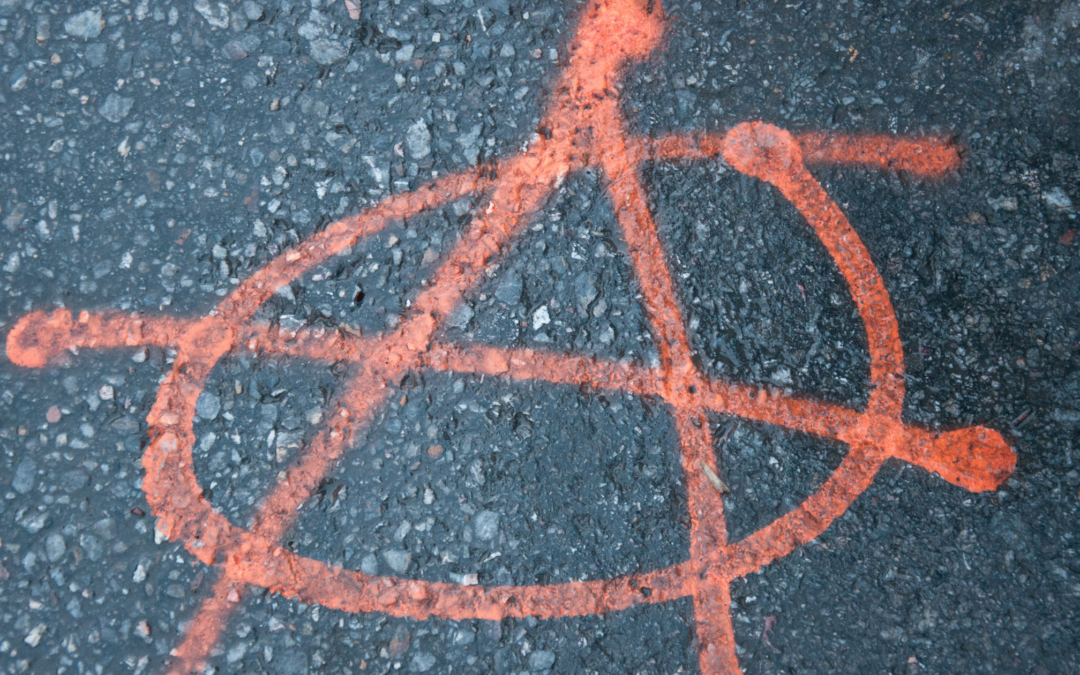Anarchism Explained: Principles, History, and Catholic Insights
This is the fifth article in a series. To learn more, see: “The -Isms Encyclopedia: Historical and Philosophical Ideas Explained” by Mr. Phillip Campbell.
When I was a kid, anarchy was just a symbol that teenage punks spray painted on the backs of their leather vests to signify their rebellion against normie social mores. I was surprised to learn that anarchism used to be a potent political force throughout the West, whose proponents were both loathed and feared by the governments of Europe and America as dangerous revolutionaries. In this article, we will examine the principles and history of the political philosophy known as anarchism.
Principles of Anarchism
Anarchism comes from the Greek word anarkhos, which means “without a chief or ruler.” In its most basic meaning, anarchism is the belief in a stateless society—that is, people living without the constraints of a government. In this respect, anarchism is often compared to libertarianism, a political philosophy that similarly advocates for the drastic reduction or elimination of the state. However, because of its focus on egalitarianism, anarchism is often considered a “leftist” philosophy, the anti-authoritarian wing of socialism.
Some of the principle ideas of anarchism are:
Anti-Authoritarianism
The backbone of anarchism is anti-authoritarianism. Anarchists regard the concept of government as inherently exploitative, existing to protect the interests of the moneyed classes by keeping the rest of society oppressed. They tend to reject any kind of social hierarchy, whether political or cultural. From the anarchist perspective, these hierarchies exist only to perpetuate the oppression of those at the bottom rungs of society. Anarchists advocate for dismantling government authority and abolishing all social distinctions to bring about a stateless society and equality among people.
Collectivism
Anarchists are collectivists and, as such, are ideologically linked with socialists and communists. As mentioned in this series entry on socialism, collectivism is the belief that the needs of the many outweigh the interests of the few. Society should, therefore, be organized to maximize the collective benefits of its members. But how can an ideology advocating the dissolution of government be collectivist? How can there be a collective if there is no authority to organize it?
Anarchists conceive of a collective, harmonious society emerging from the spontaneous organization of regular people once the oppressive state is removed. The anarchist ideal is organization without leadership, unity without a head. Russian anarchist Mikhail Bakunin said that the anarchist revolution would “create its revolutionary organization from the bottom up, from the circumference to the center, in accordance with the principle of liberty, and not from the top down or the center to the circumference in the manner of all authority.” (1) Since inequality is caused and perpetuated by the state, eliminating the government will result in the leveling of all class distinctions and the emergence of a just society.
We should note how anarchist collectivism is distinct from that proposed by communists and socialists. Both communists and socialists believe in the necessity of using government authority to collectivize society. At the same time, anarchists propose a “ground-up ” collectivization emerging from the people without the government’s aid.
Egalitarianism
Anarchists are often equated with libertarians, who also are known for their anti-authoritarianism. Where libertarians and anarchists differ is on the importance of egalitarianism, which means the equality of all people. For the anarchist, liberty from the oppressive state is a means of securing an egalitarian society where everyone has the same access to resources. The libertarian, on the other hand, desires liberty from the state as an end in itself. Libertarians, for example, would accept vast inequalities if it meant a stateless society, whereas anarchists hope the stateless society will lead to social equality. This focus on egalitarianism is why anarchists are considered “leftists,” often seen as the anti-authoritarian branch of socialism. It is important to note, however, that communists and socialists have historically rejected anarchists, frequently expelling them from their organizations.
Who’s Who of Anarchism
The history of anarchism is difficult to trace because much depends on how we define it. For example, in its ancient Greek context, anarchy was equivalent to mob rule, the final degenerate state of a dying democracy. But mob rule is not how anarchists define the state of anarchy, as anarchists see anarchy not as chaos but more akin to undirected order. At best, we can trace some of the ideas that later fused into anarchism, beginning with the thinkers of the European Enlightenment.
Enlightenment Precursors
Philosophers of the Enlightenment, such as John Locke (1632-1704) and Thomas Hobbes (1588-1679), discussed a hypothetical stateless society in what was known as the “state of nature.” However, Locke and Hobbes deemed this state of nature undesirable because of its chaos and inequality. While Hobbes and Locke both saw some form of government as necessary to remedy the chaos of the state of nature, they still agreed that to live without government was man’s “natural” state, which would become a central principle of anarchism in the coming centuries.
The Anglo-Irish political philosopher Edmund Burke (1729-1797) is sometimes seen as an intellectual forebearer of anarchism because of his distinction between government by “natural reason” and “artificial laws” imposed upon society by an oppressive ruler class. Burke’s 1756 work A Vindication of Natural Society argued that social organization should be structured around the natural institutions of the people, sentiments that would be repeated in his more famous 1790 Reflections on the Revolution in France. Burke, however, did not believe that government was inherently oppressive or evil. He merely argued that governing institutions should arise organically from the people; a position echoed today in the paleo-conservative movement.
Others have seen antecedents of anarchism in various anti-authoritarian movements: religious communities, communes, fraternal societies, and so forth. Some thinkers have even argued that the message of Jesus Christ is a kind of anarchism because of the Gospel’s emphasis on the equality of men before God and the voluntary sharing of resources among the early Christian communities. While we can draw certain parallels between these movements and anarchist thought, none approximate the systematic anarchism that emerged in the 18th and 19th centuries.
William Godwin and Wilhelm von Humboldt
One of the earliest proponents of anarchy was the British journalist William Godwin (1756-1836). Godwin was a Utilitarian who believed that the abolition of the government could attain a just society. The resulting state of anarchy would lead to a self-organizing society with a fairer distribution of resources. Godwin argued these principles in his 1793 book Political Justice. However, it should be noted that Godwin repudiated any violent means of bringing about anarchy. Instead, he believed education and gradual reform were the best ways to accomplish this. Godwin’s thought was further developed by the German Wilhelm von Humboldt (1767-1835), whose 1792 book The Limits of State Action argued for a society structured around voluntary contracts between individuals.
Pierre-Joseph Proudhon
A major development in anarchist thought came with the Frenchman Pierre-Jospeh Proudhon (1809-1865), the first thinker to self-identify as an anarchist. Proudhon used the term anarchy in a positive sense, not merely as the absence of government but as a society characterized by liberty. Proudhon was influential in the development of socialist thought as well, believing that the abolition of private property and direct democracy would bring about an egalitarian anarchist society. Following Proudhon, one can speak of an anarchist “movement” that was active in communist and socialist circles throughout the 1860s and 70s.
Mikhail Bakunin
The Russain revolutionary Mikhail Bakunin (1814-1876) was a disciple of Proudhon who popularized anarchy as a term in public discource. Bakunin viewed anarchy both positively and negatively, as a destructive revolution capable of tearing down the old order, as well as a creative force that could transform the world. Bakunin believed that the destruction of government would lead to a period of chaos and disorder and proposed the creation of an “International Brotherhood” to guide people through those difficult times into the promised egalitarian future.
Anarchism in Practice
Anarchists argue that a society without government would ultimately result in a fairer, more equitable society as people spontaneously self-organize in ways most conducive to their own good without inefficient, coercive government bureaucracy. While no country has ever been organized around these principles, the experiences of countries that have undergone governmental collapse are not promising. For example, when the governments of Somalia and Haiti collapsed in 1991 and 2018, respectively, it did not result in a spontaneous self-ordering of society around the common good. Instead, it led to wholescale take over of those countries by vicious warlords, who turned their communities into post-apocalyptic hellscapes.
Anarchism as a movement has often been considered a destabilizing presence in society. Anarchists were frequently expelled from meetings of socialists and communists due to their aversion to authority. From the 1870s to 1920, there was what we might call an “Anarchist Scare” in the United States and Europe, as anarchists increasingly turned to violent measures to push their vision. In 1874, for example, Italian anarchists Andrea Costa and Errico Malatesta planned an armed uprising in Bologna but were arrested before they could carry it out. In 1886, anarchists were widely believed to be responsible for a bombing at Haymarket Square in Chicago in which seven police officers and many bystanders were injured. And in 1901, a Polish anarchist named Leon Czolgosz assassinated U.S. President William McKinley.
Not all anarchists advocated violence, however. Russian anarchist Peter Kropotkin (1842-1921) believed that anarchism could be established through education. Kropotkin believed that small groups of anarchists should enter more prominent workers’ organizations, particularly trade unions, and agitate for social revolution through the political process.
The so-called “classical era” of anarchism lasted from 1870 (the Paris Commune) to 1936 with the end of the Spanish Civil War, after which anarchism declined as a potent political force.
The Catholic Perspective
The Catholic perspective on anarchism is challenging to tease out because people mean so many things by the word. Anarchism in its strict sense is certainly incompatible with Catholicism. The Catholic Church teaches that governments exist by will of God and are part of natural law. It is human nature that there be a hierarchy in society. Even the bliss of heaven is characterized by a hierarchy or gradation of blessedness. This is entirely contrary to the anarchist conceptions of the state as inherently oppressive, the elimination of all hierarchy, etc.
Today, however, one often sees mitigated forms of anarchism that do not argue for the absolute evil of the state but that the role of the state should be as minimized as possible. For example, anarcho-capitalists are free-market economists who argue that the state should have almost no role in the economy whatsoever. Or anarcho-distributists are distributists who advocate for the broad distribution of property through the voluntary actions of individuals without coercion from the government. In these examples, the prefix anarcho simply means “unregulated” or “with the least amount of government intervention possible.” Some, therefore, see anarchy as synonymous with the subsidiarity that the Church’s social teaching advocates, but this is hotly contested. A quick Google search will give you an idea of how endlessly this is debated across the Catholic intellectual world.
As Catholics, we affirm that Christ is king and the Church is a monarchy, possessing a hierarchical structure willed by Christ. Society, too, is organized hierarchically, with the government existing by God’s will to maintain order (cf. Rom. 12). The divine order is reflected in the natural order. Can the government become corrupt, exploitative, and oppressive? Most assuredly so. But this should spur us on to improve our governments, not eliminate them in the belief that the disorders of governmental collapse would bring about a self-regulated egalitarian utopia.
Incidentally, for an engaging and hilarious Catholic critique of anarchism, check out G.K. Chesterton’s classic novel The Man Who Was Thursday, which is loosely structured around an anarchist plot to infiltrate and destabilize Victorian-era London. For an upper-level high school student, see Dr. Henry Russell’s online course G. K. Chesterton and The Man Who Was Thursday.
What are your thoughts or questions on this topic? You can join me and other homeschooling parents at our Homeschool Connections Community or our Facebook group to continue the discussion!
(1) Peter H. Marhsall, Demanding the Impossible: A History of Anarchism (London: Harper Perennial, 2008) 281-282
This article contains affiliate links.






